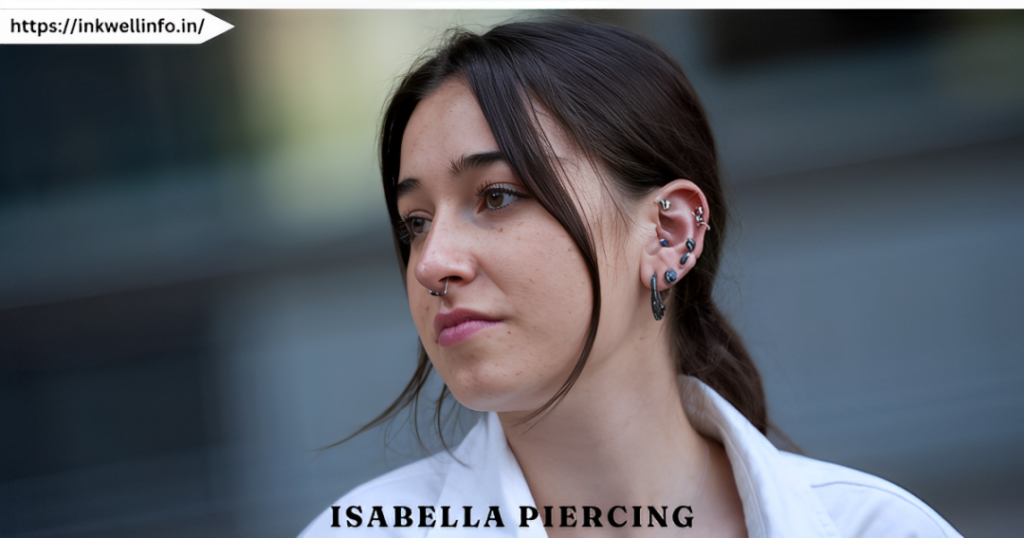What is an Isabella Piercing?
The Isabella piercing is a unique and eye-catching type of body piercing that involves the tissue underneath the upper lip, usually placed centrally. This piercing, often categorized as lip piercing, has become increasingly popular among those looking to express themselves through body art. It gives a distinct look that can be styled discreetly or made prominent with jewelry, depending on personal preference.
How is it Different from Other Lip Piercings?
Unlike traditional lip piercings, such as the labret or Monroe, typically positioned alongside the lip, the Isabella piercing is located in the center, right above the Cupid’s bow. This placement creates a striking visual and allows for a different style of jewelry, such as a twisted barbell or stud.
Anatomy Requirements for an Isabella Piercing
For ideal placement, individuals considering this piercing should have a suitable anatomical structure to minimize complications and ensure the piercing heals properly.
Pros and Cons of Isabella Piercing
Pros
- Unique Appearance: One of the biggest draws to the Isabella piercing is its ability to set you apart from others. It’s a standout feature that catches people’s eyes.
- Versatile Jewelry Options: From rings to studs, there’s a wide range of jewelry styles that can complement this piercing, making it easy to switch up your look.
- Personal Expression: Like many piercings, the Isabella is a form of self-expression, allowing you to showcase your individuality and style.
Cons
- Healing Time: As with any piercing in the oral area, the Isabella piercing can take a few weeks to heal fully. During this time, there can be some swelling and discomfort.
- Potential for Infection: The mouth can harbor bacteria, which means there’s a risk of infection if proper care is not taken.
- Jewelry Maintenance: The jewelry itself requires regular cleaning and maintenance to prevent irritation or buildup of bacteria.
History of Isabella Piercing
The history of body piercing is rich and varied, with different cultures embracing the art for its spiritual and aesthetic meanings. While the isabella piercing itself is a modern interpretation, the practice of ear piercing can be traced back thousands of years, with many societies using it as a form of identity, social status, or cultural belonging.
Notably, separate parts of the ear have seen various styles of piercing throughout history. In ancient Egypt, earrings were symbols of wealth and beauty. Fast forward to today; the isabella piercing is gaining popularity thanks in part to social media and influencers who frequently showcase this stylish addition to their ear configurations.
The Piercing Process
Getting an isabella piercing is a straightforward process, but it’s essential to choose a professional piercer who uses sterile techniques.
What to Expect
- Consultation: First, your piercer will discuss the process, aftercare, and any concerns you might have.
- Preparation: The area is cleaned with an antiseptic solution to prevent any infections.
- Piercing: A hollow needle is used to create the hole. This method is preferred over traditional piercings with a gun due to its precision and reduced risk of tissue damage.
- Jewelry Insertion: The desired earring is then carefully put in place. Here you can choose from various options, such as studs, hoops, or even decorative chain jewelry.
“It might feel a bit uncomfortable, but the sensation is brief, and many say the result is worth it!”
Aftercare Tips
Caring for your new isabella piercing is crucial to ensure proper healing and avoid any complications. Here are some friendly tips:
- Keep It Clean: Use a saline solution or a specialized piercing cleaner to gently wipe around the area twice a day.
- Avoid Touching: Try not to touch your piercing, as this can introduce bacteria.
- Stay Away from Pools: It’s best to avoid swimming pools, hot tubs, or oceans until it’s fully healed.
- Watch for Signs of Infection: If you notice redness, swelling, or pus, it’s essential to consult your piercer or a healthcare professional.
Personal anecdote: I remember when I got my first earlobe piercing; I was so nervous! But once I followed the aftercare, it healed beautifully, and I could finally wear those cute earrings I had been eyeing.
Pain Level: How Painful Is an Isabella Piercing?
The pain experienced during an Isabella piercing may vary from person to person. Many report that the sensation is quite manageable, especially compared to other piercings.
Factors Influencing Pain Experience
Anatomy: Individual anatomical differences can affect how one experiences pain.
Piercer’s Skill: A skilled piercer can make the process much smoother and quicker.
Tips to Reduce Pain
Try to relax before your appointment. Deep breathing exercises can help.
Engaging in a friendly conversation with your piercer can distract from any discomfort.
Risks and Safety Concerns
Like any body modification, the Isabella piercing does come with potential risks.
Potential Complications
Infection: This is the most common risk and can often be mitigated with proper care.
Migration and Rejection: Sometimes, the body may push the jewelry out.
Nerve Damage: Though rare, this can occur if not done properly.
Reducing Risks: Maintaining good hygiene and seeking a reputable piercer can significantly reduce risks.
Styling Your Isabella Piercing
One of the best parts about the isabella piercing is the freedom of expression it brings. Here’s how to style it:
- Mix and Match Jewelry: Pair your Isabella piercing with different styles. A dainty stud on the isabella piercing can contrast beautifully with larger hoops on other parts of the ear.
- Layering: Consider layering multiple piercings to create a more dynamic look.
- Color and Materials: Experiment with different materials like gold, silver, or even colorful acrylics to match your outfit or mood.
Cost of Isabella Piercing: What to Expect
Average Cost Range: Prices typically range from $50 to $100, depending on various factors.
Factors Affecting Price: Consider the piercer’s experience and the quality of the jewelry when budgeting for the piercing.
Investing in a Professional: While the price may seem high, the value of professional expertise cannot be overstated.
Choosing Jewelry for Your Isabella Piercing
When it comes to jewelry for your Isabella piercing, there are a few popular options:
Popular Styles
- Barbell: These are great for everyday wear and allow for easy cleaning. They typically come in stainless steel or titanium, which are both body-safe materials.
- Rings: Once your piercing is fully healed, you might want to experiment with rings for a more playful and eye-catching look.
- Studs: Simple yet elegant, studs can be a great choice for those who prefer a minimalist approach.
While selecting jewelry, it’s important to consider both comfort and style. Find pieces that reflect your personality!
Choosing the Right Piercing Studio
What to Look For
Hygiene Standards: Ensure the studio maintains high cleanliness standards.
Experience with Isabella Piercings: The piercer should have specific experience with this type of piercing.
Certifications and Reviews: Check online reviews and ask for certifications before making an appointment.
Questions to Ask Your Piercer: Inquire about their experience, aftercare guidance, and any other concerns you may have before proceeding.
Personal Experiences with Isabella Piercing
Many individuals who have opted for an Isabella piercing often say it gives them a renewed sense of confidence. For example, a friend of mine had always wanted to express herself in a cool but subtle way. After getting her Isabella pierced, she felt it brought her style together and added an exciting twist to her look.
“Getting my Isabella piercing was a big step, and I love how it highlights my smile,” she shared.
It’s amazing how a little piece of jewelry can transform not just your appearance but also how you feel about yourself.
Final Thoughts
If you’re considering an Isabella piercing, it’s wise to think about the commitment it entails—not just in terms of healing, but in how it will fit into your lifestyle and fashion choices. Ultimately, piercings are a personal choice and can be a beautiful form of self-expression.
So, if you feel ready to take the plunge into the world of Isabella piercings, go ahead! Your unique style awaits.
FAQs About Isabella Piercing
1. Can anyone get an Isabella piercing? Generally, yes, but anatomy plays a role.
2. How long does it take to heal? Typically 6 to 12 weeks.
3. Is it safe to engage in physical activities? Consult your doctor for personalized advice.
4. What type of jewelry is recommended? Start with titanium or surgical steel.
5. How do I prevent or treat infections? Regular cleaning and monitoring are key.
For More Visits; INKWELLINFO.IN



